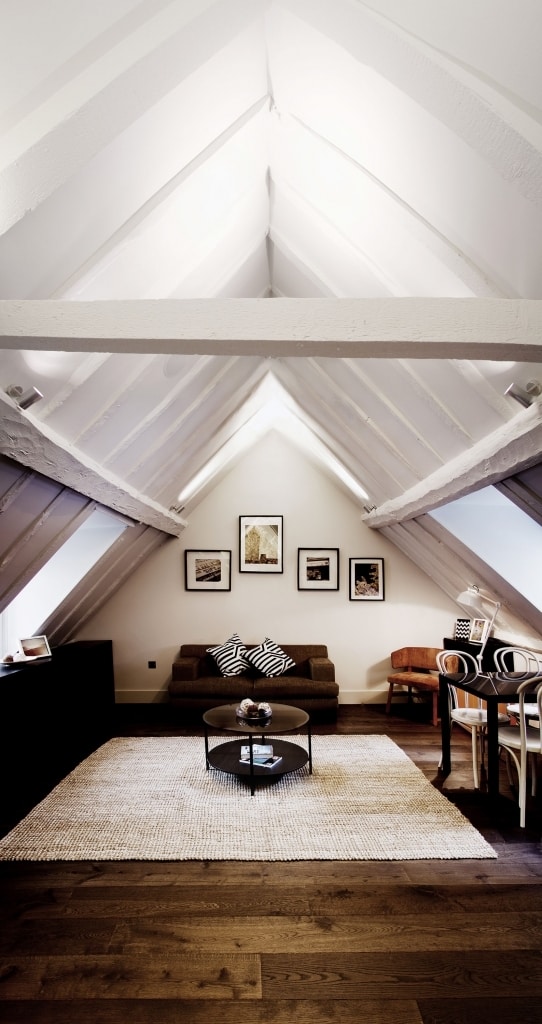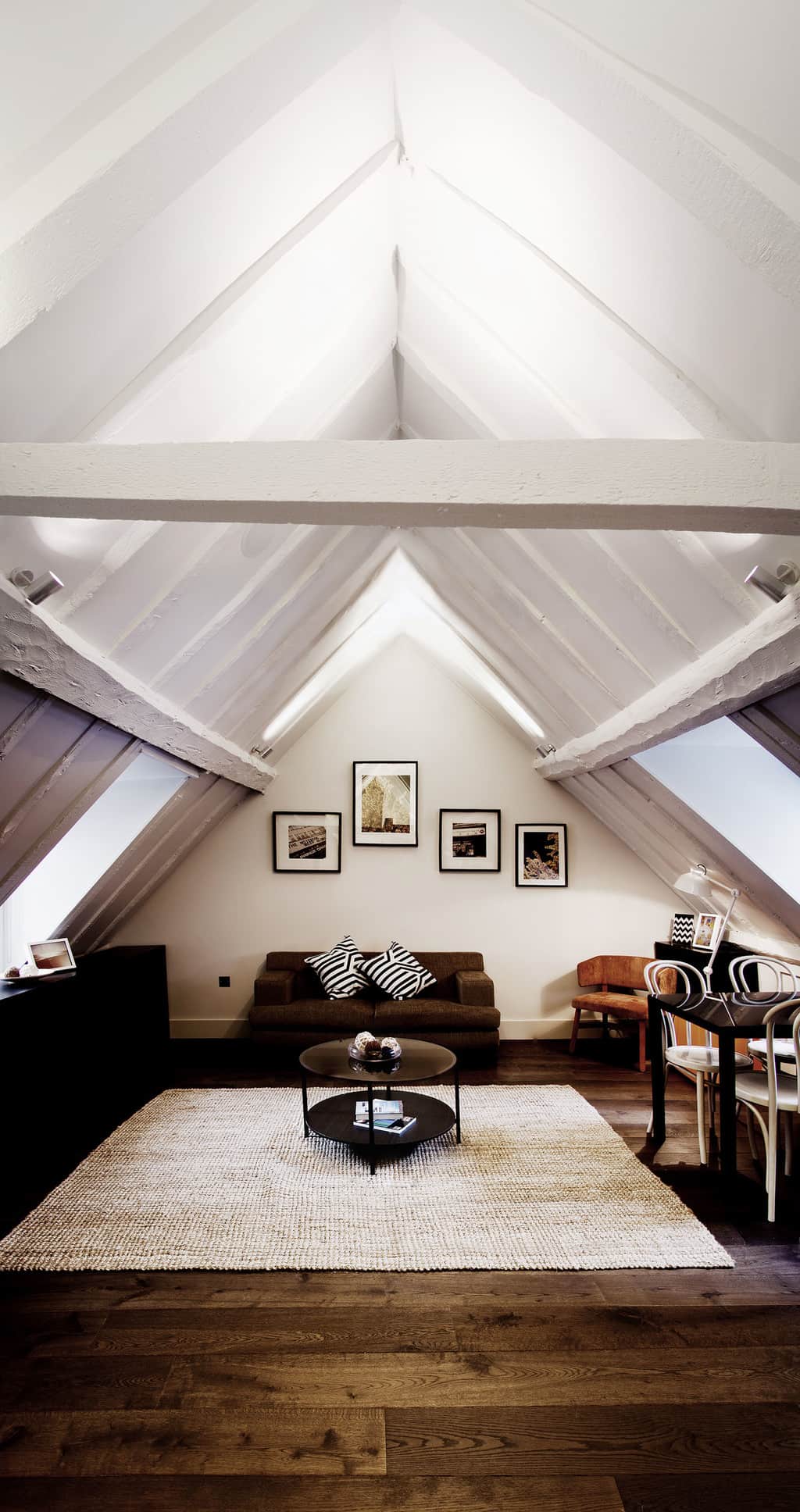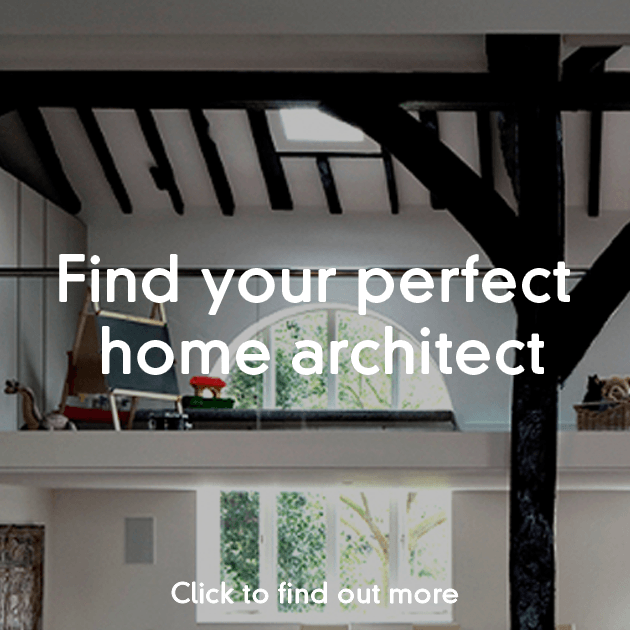What’s the minimum ceiling height allowed?
Funnily enough, this is one of the most common questions I’m asked as a residential architect. But for good reason: it’s so important to look at the most obvious constraints of a renovation project first. It will shape the brief, how much you are willing to spend on the project, and even decide if it’s worthwhile undertaking the project at all.
This weekend I’ve been house-hunting and one of my favourite bits of the viewing experience is to hear the estate agent’s renovation ambitions for the house. ‘You could easily convert the loft in to a bedroom and ensuite,’ he shouts up at me as I’m arching my neck to stand up and ducking under rafters. Not unless we spend thousands lowering the ceiling and re-constructing the roof, I think!
(Left image: loft conversion by architect, Simhika – click on the image to shortlist them for your project)
Average ceiling heights
You may be pleased to hear that there are no legal requirements for ceiling heights in homes in the UK (except where stairs are involved – see the building regs. section below). However, there are expected standard ceiling heights. If you want to sell your house in the future, I’d recommend sticking to these:
Minimum ceiling height : 210 cm (200cm if really pushing it!)
Standard ceiling height: 240 cm
Good ceiling height: 260 cm
You could get away with 210 cm – 240 cm for studies, bathrooms, children’s rooms etc. quite easily, but I’d recommend keeping above 240 cm for living areas and master bedrooms if you can.
Sloping ceilings
In a loft conversion, or perhaps even a sloping side extension, try and arrange the layout so storage or furniture is positioned in these areas keeping the highest points free for moving around in. Ideally, at least 50% of the space should have a ceiling height of 210cm or above.
Minimum ceiling height – building regulations
As mentioned above there is no minimum room height defined by the Building Regulations, but there are rules around staircases and access:
Part K of the Building Regulations is all about ‘protection from falling, collision and impact’, and advises that the head height for landing and stairs should be at least 2m as shown in the diagram below (from Approved Document K):
![]()
There’s a very handy exception to this rule for loft conversions:
![]()
Minimum ceiling height – estate agents’ calculations
For estate agents’ area calculations, they include areas that have a head height of more than 1.5m (and also under stairs) according to RICS guidance.
Yikes. So pretty low standards then!
RICS also try to define what is classified as a bedroom: ‘There is no statutory definition of the term “bedroom” in the UK. The term is used to describe a room used for sleeping in and where you would expect to find a bed or other such piece of furniture designed for sleeping on… An indicator that a room can be used as a bedroom could be that at least a small single bed will fit into it, and in most cases it will have a window, although there is no legal requirement.’
Minimum ceiling height for mezzanine
Depending on what the mezzanine is used for, you could get away with 1.5m.
A mezzanine sometimes known as a sleeping gallery, can be brilliant for carving out usable space in your home when you are lacking in square feet. Where a loft conversion isn’t possible due to limited room height, you could consider opening up your loft space to, say, your living area, this should be carefully considered and worth asking an expert, as it would normally involve a major structural alteration. This would give your living space a fabulously high ceiling! A mezzanine could be really great for a workspace or guest bed (i.e anything that involves sitting/lying down so head height isn’t as much of an issue). It would be best to ask an architect as there is quite a bit to consider, such as fire safety, type of stairs and structural works.
Loft conversions – how much height will I lose through finishes and insulation?
If you haven’t already, get up into your loft with a tape measure (but only if it’s safe, obviously). Do be aware that you will probably lose some height because of the need for insulation and floor/ceiling finishes (roughly 20-25cm). It may be slightly less or more than this, but depends on your existing roof structure, which also may need to be configured to remove any struts that you currently need to step over to move around the space.
So, if you measure from the existing ceiling joists up to the highest point or ridge beam, there will need to be at least 220cm (see diagram below) to achieve a minimum ceiling height of 2 metres.
![]()
Other important considerations for a loft conversion/ extension
- To meet building regulations, there must be a ‘protected’ escape route, meaning the stairs and hallway cannot be open to other rooms and these rooms must all have doors which have a 30-minute fire rating. So you might need to upgrade or replace your doors. There maybe another option which would be to install a sprinkler system, this can involve a complex design and is best undertaken by a specialised designer, before being checked by a Building Control Body such as an Approved Inspector.
- Do you need planning permission? Certain loft conversions do not require planning permission if they fall within the permitted development allowance. (Note: permitted development applies only to whole houses, and not flats or maisonettes, or if you are in a conservation area)
- Make sure you own your loft space if you are a leaseholder, and even if you do, you will still need to seek permission from the freeholder.
- See our article all about loft conversion costs here: https://designfor-me.com/advice-and-tips/how-much-does-a-roof-conversions-cost/
A big thank you to Nick Paley who helped with this article. Nick is from Assure Building Control. They have local offices nationwide, so if you need some further assistance with building control matters, they’d be happy to hear from you: www.assurebuildingcontrol.co.uk
Do I need an architect for a loft conversion?
You don’t necessarily need architect for your loft conversion or extension, but you will need someone to design and detail it! This might be an ARB registered architect, an architectural technologist or technician. Read our article here to find out the difference.
Specialist loft conversion companies (or ‘design and build’ contractors) often have in-house designers/architects, and will quote for the entire job. This cost certainty can be very appealing, but it doesn’t necessarily work out cheaper and you may be compromising on getting a great design. If you have a project that is complex in some way, or you would like a little more creative thinking, speaking to a couple of independent architects (or ‘architectural designers’) may be well worthwhile. There are also advantages in your designer working for you, rather than for your builder, and it may not cost as much as you think for a set of concept drawings that your builder could take on and develop.
We love this more unusual conversion, designed by Scott from Design for Me:
Finding the right designer/builder
Design for Me helps homeowners find the right architect or designer for their project, no matter how big or small. We have residential architects, technologists, and also designers from loft companies registered with us. Once you’ve posted your project, we’ll send it out to all your best matches in your area to see who’s available and eager to take it on. You can choose up to three for a consultation. There’s no obligation to take it further with anyone, AND it’s completely free!
Emily Design for Me



